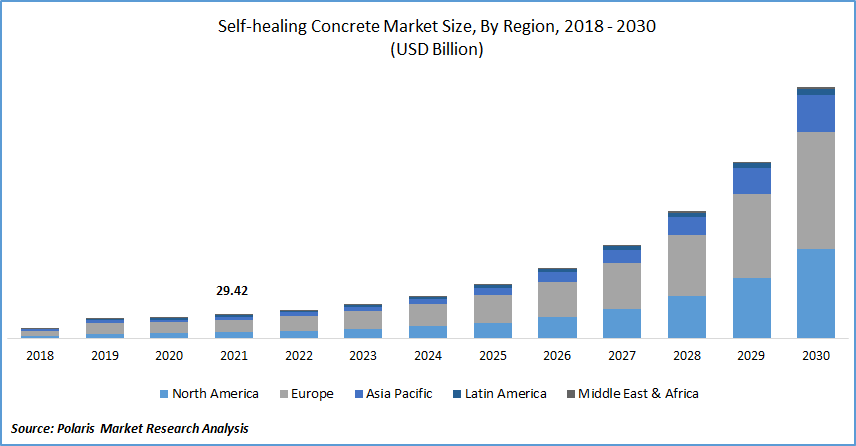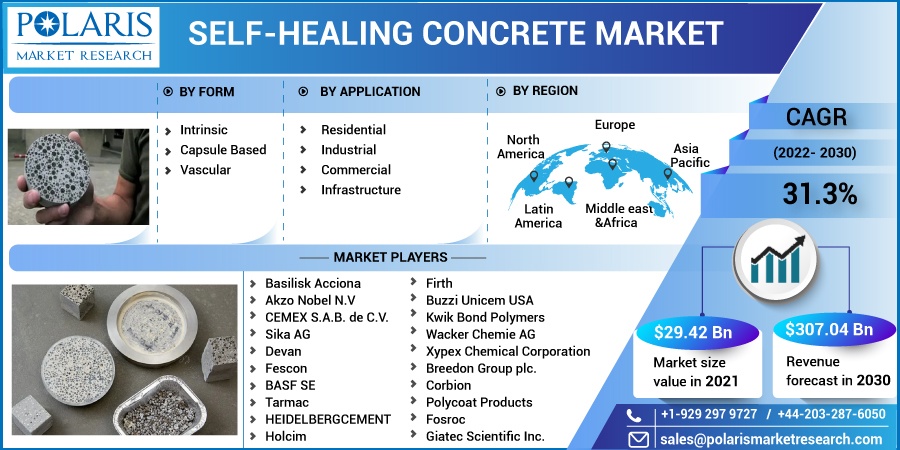
Self-healing Concrete Market Share, Size, Trends, Industry Analysis Report
By Form (Intrinsic, Capsule, Vascular); By Application (Residential, Industrial, Commercial, Infrastructure); By Region; Segment Forecast, 2022 - 2030
- Published Date:Oct-2022
- Pages: 114
- Format: PDF
- Report ID: PM2632
- Base Year: 2021
- Historical Data: 2018 - 2020
Report Outlook
The global self-healing concrete market was valued at USD 29.42 billion in 2021 and is expected to grow at a CAGR of 31.3% during the forecast period. Self-healing treatments can quickly fix the fractures since the self-healing mechanism enables quick mending. Due to the shortcomings of the current treatments, innovative and alternative treatment techniques like polymeric material encapsulation and self-healing are in high demand. Over the projection period, adoption of such cutting-edge technologies will drive industry expansion.
 Know more about this report: Request for sample pages
Know more about this report: Request for sample pages
A new sort of concrete called self-healing concrete mimics how bodily wounds automatically heal through the production of some kind of material. Utilize various components, such as fibres or capsules that disperse adhesive solutions throughout the actual mixture, to create self-healing concrete.
Due to the rise in demand for infrastructure and building maintenance savings, the market is anticipated to develop rapidly in the approaching years. Self-healing concrete market provides workable solutions to lengthen the lifespan of buildings and structures, gaining popularity in the building industry.
Traditional concrete and its associated materials are prone to cracking with time, increasing stress on walls and beams. Self-healing concrete market is utilised in the building process to help with crack repairs and minimise building upkeep. By using microorganisms included in the materials, this specialty concrete creates limestone.
When the pandemic is gone, this industry’s demand and growth will resume to pre-pandemic levels, which explains the abrupt decrease in CAGR. The industrial and logistics sectors have been significantly impacted by COVID-19, which has hurt the industry. The worldwide interconnected vehicle industry was significantly impacted by the COVID-19 epidemic.
The industry impact includes a suspension of Chinese exports, particularly of raw materials for plastics and coatings, extensive commodity destruction in Europe, and the closing of American manufacturing facilities. Despite this, more than 80% of the world's automotive supply chain is controlled by China. In January 2020, car prices fell by 18% in China.
 Know more about this report: Request for sample pages
Know more about this report: Request for sample pages
Industry Dynamics
Growth Drivers
The expansion of self-healing concrete is anticipated to expand as more institutions, office buildings, healthcare facilities, restaurants, educational facilities, hotels, and other commercial complexes are constructed. Additionally, implementing technological improvements in construction to increase structural durability is likely to positively assist industry expansion.
Global demand for self-healing concrete market is rising as a result of rising investment in large-scale infrastructure projects. An important aspect that is boosting the revenue growth of the worldwide self-healing concrete market is the fact that many emerging nations are investing in and working together on infrastructure projects for long-term benefits.
One of the main elements influencing the market's optimistic outlook is the substantial expansion of the worldwide construction sector. The industry is expanding as a result of the rising need for durable, trustworthy, and environmentally friendly buildings. In accordance with this, the market is also expanding as a result of the extensive use of vascular-based healing technologies in contemporary building construction. They are made up of a system of tubes filled with self-healing concrete that are inserted into the walls to strengthen the building.
One of the main driving forces in a developing economy like India is the expansion of building operations for both public and private infrastructure. The domestic manufacturing processes are supported by government programmes like the Make in India campaign, making it simple to obtain the raw materials needed by the building sector.
Due to the product's durability and versatility in infrastructure, the building sector would benefit. Additionally, the market will be further stimulated by the growing use of CMCs, composites, and polymer-based materials in construction.
Report Segmentation
The market is primarily segmented based on form, application and region.
|
By Form |
By Application |
By Region |
|
|
|
Know more about this report: Request for sample pages
Vascular form accounted for the largest revenue in 2021
The self-healing concrete's vascular form, which had the biggest revenue share in 2021, is predicted to expand at the fastest rate over the projection period. This type is utilised when a network of tubes containing concrete-specific healing agents are transferred from the inside to the exterior of the building walls. The technology is not ubiquitous since these tubes must be installed at expected sites where the fracture is likely to appear.
Vascular-based healing technology involves passing a network of tubes through the concrete framework of the building walls from the inside to the exterior while they are filled with concrete-based healing agents. Depending on a variety of elements, including the geometry of the structure, the strength of the concrete, and the different healing chemicals, this technique may be used through a single or multi-channel approach.
Infrastructure application segment is likely to witness significant growth
In terms of revenue, the infrastructure application category had the highest share in 2021 and is anticipated to increase significantly over the next several years. The increasing efforts by construction businesses to work with product development companies to market a product for the durability of infrastructure are anticipated to increase product demand.
Due to the heavy-duty operations, such as the transportation of cars, the use of large machinery, and heat treatments, industrial building must endure severe mechanical impacts. So, it makes sense that it would become more popular in industrial building, where great resistance to a variety of physical and chemical elements is necessary to meet technical demands for a surface that is both safe and practical for industrial processes.
Europe dominated the global market in 2021
Europe led the worldwide market and is anticipated to have considerable growth throughout the foreseeable future. Positive signs about private and governmental debt in Europe are promoting the expansion of the construction sector, which is anticipated to favorably contribute to market growth.
Germany and other Western European nations make a substantial contribution to the expansion of the global building market. The government's numerous initiatives and ongoing projects have fueled the market's expansion. The nation during the pandemic took better supporting measures for its economy, which led to the country's positive growth in comparison to the U.K. and France.
One of the more established markets for concrete goods is North America. Multinational corporations that deal with concrete products and associated raw materials are well-represented in the area. These businesses' investments in R&D resources and product innovation have greatly aided the market's expansion as a whole.
The expanding requirements of a growing population are to blame for the expansion of the building sector in the Asia Pacific region. A large consumer base, cheap labour, an abundance of resources, and rising per capita income among the middle class in nations like China and India are additional factors that are expected to contribute to the growing economic importance of Southeast Asian nations, China, India, and other nations, which is expected to fuel the growth of the construction sector.
Competitive Insight
Some of the major players operating in the global market include Basilisk Acciona, Akzo Nobel N.V, CEMEX S.A.B. de C.V., Sika AG, Devan, Fescon, BASF SE,Tarmac, HEIDELBERGCEMENT, Holcim, Firth, Buzzi Unicem USA, Kwik Bond Polymers, Wacker Chemie AG, Xypex Chemical Corporation, Breedon Group plc., Corbion, Polycoat Products, Fosroc, Giatec Scientific Inc.
Recent Developments
Acciona created Self-healing materials in April 2015 to increase the usefulness and longevity of the infrastructures. The Shine and Healcon European initiatives, which aim to create concrete and road surfaces that can heal themselves, include Acciona Infrastructures.
Autonomic Materials looked at the Self-healing materials with protective coating systems in January 2020. Trials demonstrated the high value of the low VOC aqueous Self-healing coating for corrosion resistance.
In a deal valued at around USD 2.30 billion in December 2021, French rival Compagnie de Saint-Gobain S.A. agreed to purchase GCP Applied Technologies Inc. for USD 32 per share. One of the top manufacturers of building chemicals, Saint-Gobain anticipates post-merger total revenues of more than USD 4.51 billion.
Self-healing Concrete Market Report Scope
|
Report Attributes |
Details |
|
Market size value in 2021 |
USD 29.42 billion |
|
Revenue forecast in 2030 |
USD 307.04 billion |
|
CAGR |
31.3% from 2022 - 2030 |
|
Base year |
2021 |
|
Historical data |
2019 - 2021 |
|
Forecast period |
2022 - 2030 |
|
Quantitative units |
Revenue in USD billion and CAGR from 2022 to 2030 |
|
Segments covered |
By Form, By Application, By Region |
|
Regional scope |
North America, Europe, Asia Pacific, Latin America; Middle East & Africa |
|
Key companies |
Basilisk Acciona, Akzo Nobel N.V, CEMEX S.A.B. de C.V., Sika AG, Devan, Fescon, BASF SE,Tarmac, HEIDELBERGCEMENT, Holcim, Firth, Buzzi Unicem USA, Kwik Bond Polymers, Wacker Chemie AG, Xypex Chemical Corporation, Breedon Group plc., Corbion, Polycoat Products, Fosroc, Giatec Scientific Inc. |
